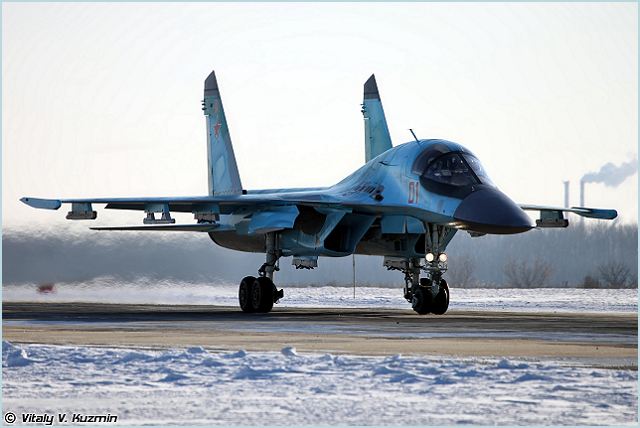The
deal under which the warplanes are to be delivered by 2020 was signed
by Defense Minister Anatoly Serdyukov and Sukhoi General Director Igor
Ozar.
This is one of the largest warplane contracts under the government arms
procurement program and it will help replace all of the Su-24 bombers
currently in service with the “4+ generation” aircraft, Serdyukov
said.
The Ministry will take delivery of 10 Su-34s in 2012,
all of them to be deployed in the Western Military District. Last year
six fighter-bombers were delivered to the Air Force. These come under
an initial contract for 32 Su-34s.
At present the Air Force has 12 Su-34s.
Factoring in the new contract, the Air Force will have a total of 124
Su-34s.
The ministry previously said a total of 70 Su-34s will be delivered
by 2015.
Commenting on the deal, Douglas Barrie, air warfare specialist at International
Institute for Strategic Studies in London, said “the Su-34 - previously
known as the Su-27IB - has been long in the gestation.”
“The program began in the 1980s and has suffered as a result of
funding problems. It is entering service well over a decade after it
was envisaged originally to be replacing the Su-24 Fencer.”
However the Su-34 will - with the appropriate avionic and weapons systems
- provide the air force with a capable long range strike platform, with
considerably more punch than the Su-24, he said.
“Work is continuing to integrate modern air-to-surface weaponry
now in development in Russia on the Su-34, with trials being carried
out at the air force test center at Akhtubinsk.”
The news of the contract comes a week after Russia partially resumed
flights of Su-24 Fencer tactical bombers after one of them crashed in
Russia’s Urals.
All Su-24s were grounded after the crash, in the woods of the Kurgan
region during a routine flight on February 13. Both pilots ejected safely.
The crash was the third of a Su-24 in Russia over the last four months.
The two previous crashes occurred in October and December 2011.
It has been in service with the Russian Air Force since the mid-1970s.
However, in recent years Russia has gradually been phasing out the planes,
which have a patchy safety record.
The Defense Ministry earlier said the Air Force will procure over 1,500
new aircraft by 2020.
Russia started the full-scale production of Su-34s in 2008 at a Novosibirsk-based
aircraft-manufacturing plant, a subsidiary of the Sukhoi Aircraft Holding.
Designed by Sukhoi, the $36-million Su-34 fighter-bomber is a two-seat
strike aircraft fitted with twin AL-31MF afterburner turbojet engines.
It is designed to deliver high-precision strikes on heavily-defended
targets under any weather conditions, day or night, and is equipped
with a 30-mm GSh-301 cannon, up to 12 Alamo or Archer AAMs, ASMs, and
bombs.
|




















